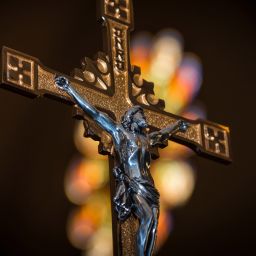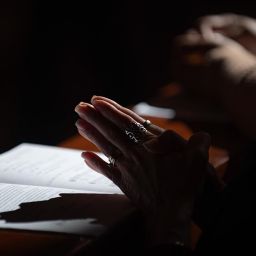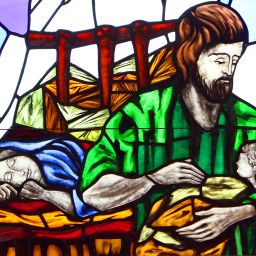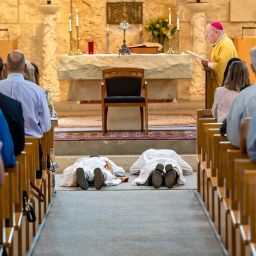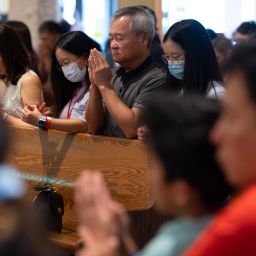By Father John Bayer, O. Cist.
Special to The Texas Catholic
Last month, 60,000 Catholics gathered in Indianapolis for the 10th National Eucharistic Congress in the USA (and the first in 83 years). I couldn’t be there, but I heard wonderful things about it from those who were. You can read about it and get involved in the evangelical momentum building in our country through the National Eucharistic Revival by going to www.eucharisticrevival.org.
Providentially, right after the congress — for the whole month of August — we read every Sunday from John 6, that incredible moment when Jesus powerfully and provocatively announced His desire to become true food for us, to become the real nourishment that takes our frail humanity and vivifies it for eternal life. Here, in the image of miraculously multiplied loaves and fishes, the Eucharist is foreshadowed, the food that truly satisfies by its spiritual depth and superabundance. John the Evangelist thought it was important to record that Jesus performed this miracle as “The Jewish feast of Passover was near” (Jn 6:4); of course, that connects the event and discourse about Jesus’s flesh and blood to the Last Supper, which is the last Passover meal that Jesus shared with His disciples — that meal through which He once prefigured and now perpetuates His Passion, Death and Resurrection; that meal when He took bread and wine and declared it to be His body and blood given up for the life of the world.
Inspired by the congress, let us commit to finding ways to share in the National Eucharistic Revival — we can watch the talks online; read about the Eucharist; attend adoration and Mass; pray, serve and sacrifice for the poor; and simply let our every action spring from the self-giving love of Jesus in the Eucharist.
Hoping for renewal, I want to focus in this article on just one eucharistic idea: the hidden possibilities of transformation in ourselves and in our country. As Christians, we should know that God “is able to accomplish far more than all we ask or imagine, by the power at work within us” (Eph 3:20). Feeding on the Eucharist, we have Jesus eternal life budding within us (Jn 6:53-54) because we have Him within us (Jn 6:56-57). We may not look like much on the outside, but with God “at work within us,” there is no telling what we will become. So much is hidden. In Christ, we have died to our former life, and now our “life is hidden with Christ in God” (Col 3:3) and waiting to be revealed in glory when He returns (Col 3:4). Looking at our frail bodies and lives, this promise can seem difficult. Indeed, how can the Son of God give us His flesh to eat (cf. Jn 6:52)? How can we frail and sinful people live the very life of God?
There is an analogy in nature that might, perhaps surprisingly, expand our imagination and encourage us to deeper faith in God’s power. Bear with me for a moment.
As an organism, we all have a genetic sequence that underlies the diverse traits we exhibit, traits ranging from our anatomy and hair color to our psychological predisposition. These traits are often only one possible expression of that genetic sequence. In other words, our DNA — hidden away in the microscopic recesses of our cellular nuclei, in secret spaces that, for most of us at least, are as remote as any other invisible power — contains so much more potential than what we actually see expressed in ourselves. What we do see (or our “phenotype”) is produced by the interaction of our genes (or our “genotype) with the many factors in our experience, including our circumstances and choices — and food.
The science investigating these interactions is called epigenetics: “Epigenetics refers to how genetic material is activated or deactivated — that is, expressed — in different contexts or situations” (David S. Moore, “The Developing Genome,” 14). To see the power of these interactions — and to see just how much food can reveal about our potential — consider honeybees. Worker bees and queen bees are genetically identical, but they are very different anatomically and behaviorally. (The queen has mature ovaries, while the workers are infertile; she is twice as large and has 20x the lifespan, while only the workers have stingers and pollen baskets.) What determines whether one bee will become a queen or a worker depends, at least in part, on whether she is fed more royal jelly than the others.
You can see where I am going with this. Even on the natural level, the depths of our nature hold secrets beyond our imagination. So, like a little food methylating a bee’s DNA can turn her into a queen, the supernatural food of the Eucharist can nourish our nature, elevated through baptism, and thereby enable us to share in the life of God. We must never underestimate ourselves when God makes a promise. Renewal and new life are possible. Let us believe it and stake everything upon it.
Father John Bayer, O. Cist., is a monk at the Cistercian Abbey of Our Lady of Dallas in Irving.



